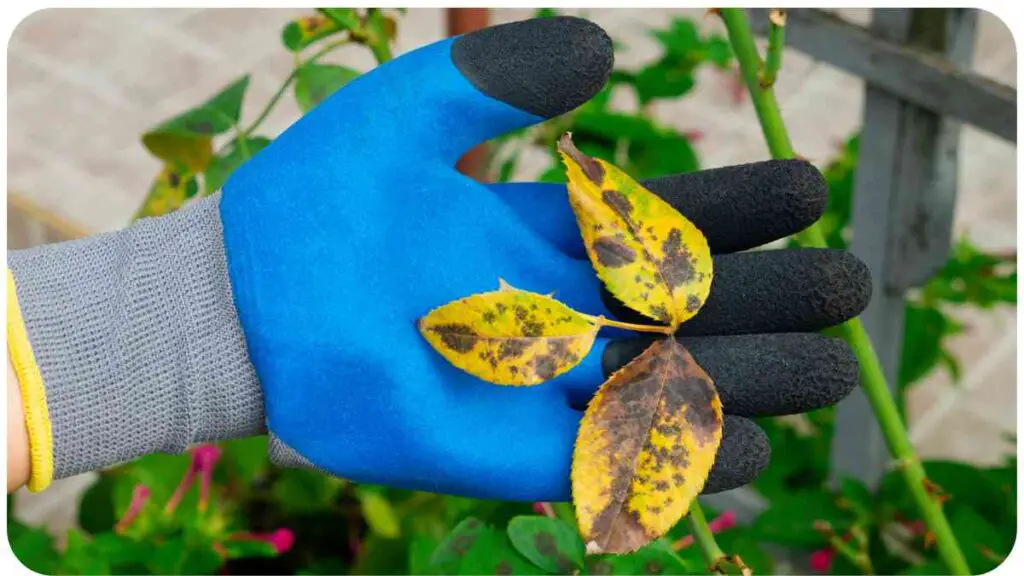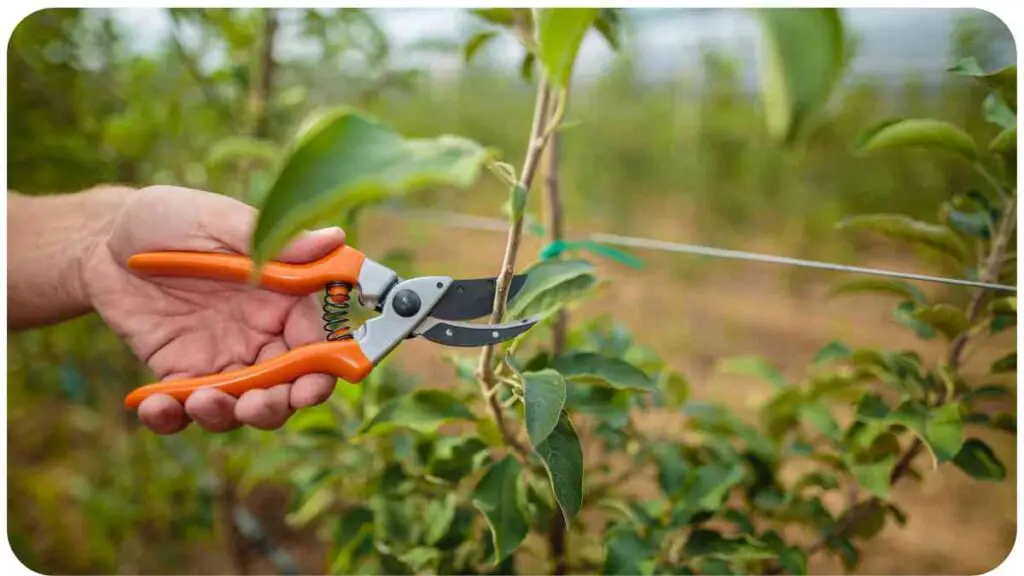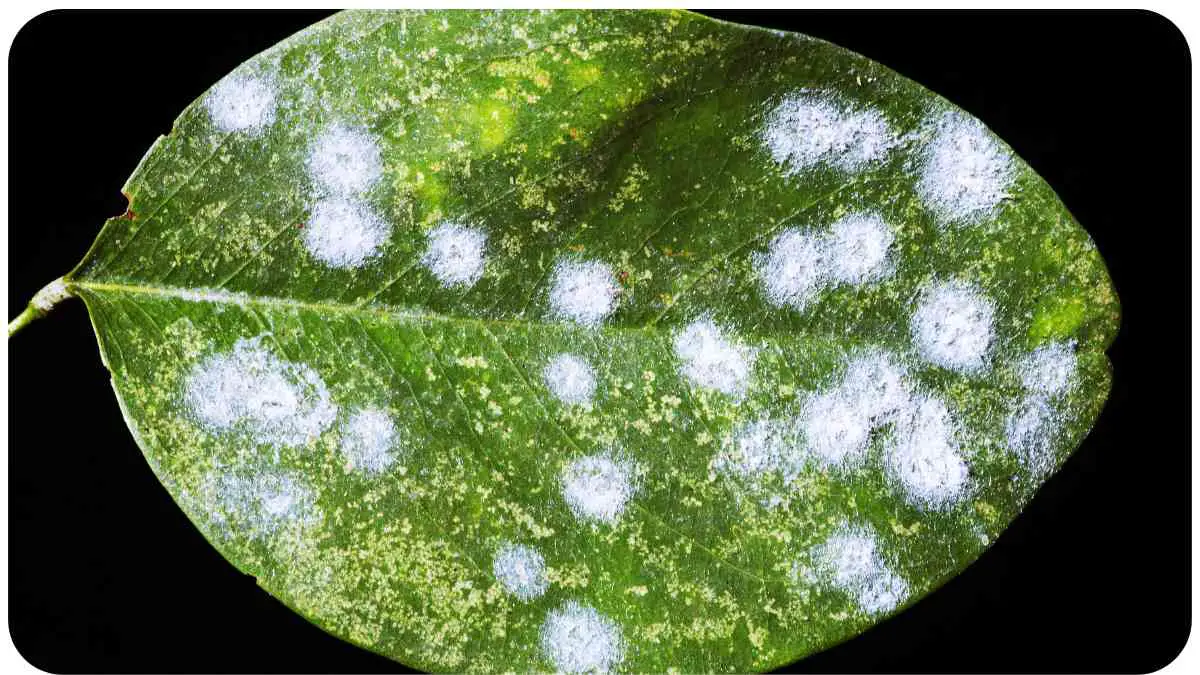Greetings fellow gardening enthusiasts! If you’ve ever nurtured a garden, you know that watching your plants thrive is one of life’s most rewarding experiences. However, just like any living beings, plants can fall victim to pesky fungal diseases.
Fret not, for this comprehensive guide is here to equip you with the expertise and practical know-how to identify and treat these fungal foes. Join me as we dive deep into the world of fungal diseases in plants and learn effective strategies to ensure your garden flourishes.
| Key Takeaways |
|---|
| Identify fungal diseases early through careful plant inspection and vigilant monitoring. |
| Maintain proper plant hygiene to reduce the risk of fungal spore spread. |
| Implement effective cultural practices such as proper watering, pruning, and plant spacing. |
| Consider natural remedies like neem oil and baking soda spray for fungal disease prevention. |
| Choose disease-resistant plant varieties to build a resilient garden ecosystem. |
| Use chemical treatments as a last resort and follow safety guidelines. |
| Learn from real-life case studies to apply practical strategies in managing fungal outbreaks. |
| Embrace emerging technologies for precision disease management. |
| Understand the impact of climate change on fungal disease proliferation. |
| Equip yourself with knowledge through resources for continued learning and support in gardening. |
Understanding Fungal Diseases in Plants
What Are Fungal Diseases?
Fungal diseases are caused by microscopic organisms known as fungi. These tiny troublemakers can infiltrate your plants, disrupting their growth and causing various ailments. From mild leaf spots to more serious root rots, these fungal invaders can leave your precious garden in a sorry state.
Plants can communicate their health through their appearance. When you notice a yellowing of leaves, it could be due to several reasons. Dive into the comprehensive solution for yellow leaves to ensure your plants remain vibrant and healthy.
Common Types of Fungal Diseases
Here’s a table highlighting some prevalent fungal diseases and their characteristics:
| Disease | Affected Plants | Symptoms |
| Powdery Mildew | Roses, Cucurbits | White powdery spots on leaves |
| Black Spot | Roses | Dark black or purple spots on leaves |
| Leaf Rust | Ornamentals, Trees | Orange or reddish pustules on leaves |
| Damping-Off | Seedlings | Wilting, collapsing seedlings |
Signs and Symptoms

Spotting the signs of a fungal infection is crucial for timely intervention. As a seasoned gardener, I’ve encountered my fair share of these symptoms firsthand:
- Leaf Discoloration: Keep an eye out for leaves turning yellow, brown, or even black. Discoloration often signifies an underlying fungal issue.
- Spots and Lesions: Irregular spots, lesions, or patches on leaves can be early indicators of a fungal invasion.
- Wilting and Drooping: If your once perky plants start to droop and lose their vigor, it’s time to investigate further.
- White Powdery Coating: The infamous powdery mildew manifests as a white, powdery coating on leaves and stems.
Your garden is a haven for many creatures, but not all of them are welcome guests. Some pests can damage or even destroy your plants. Discover the best tips and tricks for dealing with garden pests and keep your green oasis thriving
Factors That Contribute to Fungal Infections
Understanding the factors that facilitate fungal infections is like having a secret weapon in your gardening arsenal. Here’s a snapshot of these contributing factors:
| Factor | Impact on Fungal Spread |
| High Humidity | Creates favorable conditions |
| Poor Air Circulation | Prevents moisture dissipation |
| Overhead Watering | Splashes spores onto leaves |
| Crowded Planting | Reduces air movement |
| Infected Tools | Spreads diseases |
Importance of Early Detection
The Role of Regular Plant Inspection
Imagine you’re a plant doctor, making your rounds in the garden clinic. Regularly inspecting your plants is akin to giving them a wellness check-up. By spotting signs of distress early, you can administer treatments before issues spiral out of control.
Recognizing the First Signs of Infection
Training your eyes to recognize the subtlest changes in your plants is an art that comes with experience. When I was starting, I often questioned whether certain spots were normal or worrisome. But with time, I developed a keen eye for detail. Remember, it’s always better to be cautious and investigate further.
Stay tuned for the next section where we’ll explore effective cultural practices to prevent and manage fungal diseases while sharing some of my personal experiences along the way. Your garden’s health is in your hands!
Effective Cultural Practices
In my gardening journey, I’ve found that prevention is often the best cure when it comes to fungal diseases. Let’s dive into some proven cultural practices that can help you create an environment where fungi struggle to thrive.
Proper Watering Techniques
Think of your plants’ roots as Goldilocks – they like their water just right. Overwatering can lead to soil saturation, creating a haven for fungal growth. Conversely, underwatering stresses plants, making them susceptible to infections. Keep a watering schedule and aim to water at the base of plants, minimizing leaf wetness.
Every gardener fears the sight of wilting plants. It’s a sign of distress and indicates that something is not right. Don’t panic, as with the right knowledge and techniques, you can help revive your wilting plants and bring them back to life
Soil Drainage and Aeration
A table to illustrate the impact of soil drainage and aeration on fungal diseases:
| Soil Condition | Impact on Fungal Diseases |
| Well-Draining Soil | Prevents waterlogged environments |
| Ample Aeration | Reduces excess moisture retention |
Pruning and Plant Spacing

Personal experience alert! In my garden, I once neglected to prune overcrowded branches. The result? Fungal diseases spread like wildfire. Regular pruning and proper plant spacing enhance air circulation, reducing humidity around plants – a key deterrent for fungi.
Choosing Resistant Plant Varieties
Just as some people have stronger immune systems, certain plant varieties exhibit natural resistance to specific fungal diseases. Opt for disease-resistant varieties whenever possible. It’s like giving your garden a superhero suit to battle potential infections.
Stay tuned for the next section, where we’ll explore natural remedies and preventive measures that have saved my garden from the clutches of fungal invaders.
Not all plants grow at the expected rate, and sometimes, they might exhibit stunted growth. The reasons can vary, but the solution lies in understanding the root cause. Explore the troubleshooting guide for stunted growth in vegetable gardens to nurture healthy, fast-growing plants.
Natural Remedies and Preventive Measures
Neem Oil Solution
Neem oil, derived from the neem tree, is my go-to weapon against fungal diseases. It not only acts as a fungicide but also disrupts the life cycle of pests that often accompany these diseases. Mix neem oil with water and a dash of dish soap, then spray onto affected plants for a potent defense.
Baking Soda Spray
Ah, baking soda – the kitchen ingredient turned gardener’s ally. A baking soda spray can help control fungal diseases like powdery mildew. It alters the pH on leaf surfaces, making it inhospitable for fungi. Here’s a simple recipe: mix 1 teaspoon of baking soda, 1 quart of water, and a few drops of liquid soap.
Stay tuned for more natural remedies and insightful anecdotes that’ll make your gardening journey even more rewarding!
Proper Plant Hygiene
Maintaining good plant hygiene is akin to promoting good health habits in humans. Regularly remove fallen leaves, dead plant material, and weeds from your garden. These can harbor fungal spores, giving them a chance to pounce on your plants.
Beneficial Fungi for Soil Health
It might sound counterintuitive, but introducing beneficial fungi to your soil can actually help combat harmful ones. Mycorrhizal fungi form a symbiotic relationship with plant roots, enhancing nutrient uptake and crowding out potential pathogens.
Chemical Treatments
While I’m a firm believer in natural remedies, there are instances when chemical treatments are necessary. Fungicides, when used judiciously and following safety guidelines, can be effective in managing fungal diseases. Here’s a table outlining some common fungicides and their application methods:
| Fungicide | Application Method |
| Copper-Based Fungicides | Spray during dry weather |
| Sulfur-Based Fungicides | Dust onto plants or spray as directed |
| Systemic Fungicides | Applied to soil or absorbed by leaves |
Case Studies: Navigating Fungal Outbreaks
Rose Garden Blight: A Personal Account
Ah, my rose garden – my pride and a canvas for countless gardening lessons. One season, a sudden outbreak of black spot turned my radiant roses into a sorry sight. Swift action was needed! I pruned affected leaves, increased air circulation, and used a neem oil solution. The roses bounced back, reminding me of the importance of vigilance.
Watering is essential for any garden, but sometimes irrigation systems can pose challenges. From leaks to pressure issues, many things can go wrong. Equip yourself with the right knowledge by exploring common irrigation system problems and solutions and ensure a well-hydrated garden
Orchid Fungal Woes: Lessons Learned
My orchid journey wasn’t without its share of fungal battles. Overwatering led to root rot in some of my prized orchids. It was a heartbreaking experience, but it taught me the value of balance in moisture management. I repotted with well-draining mix, trimmed affected roots, and placed the orchids in a drier environment. They gradually regained their vitality.
Stay tuned for a glimpse into the future of fungal disease management and its intriguing challenges.
Future of Fungal Disease Management
As we march into the future, the battle against fungal diseases in plants is set to evolve. Emerging technologies offer innovative solutions, from precision application of treatments using drones to advanced sensors that detect early signs of infection. However, there’s a twist – climate change is playing a role in reshaping the landscape of fungal diseases.
Emerging Technologies
A table showcasing emerging technologies in fungal disease management:
| Technology | Advantages |
| Drone Applications | Targeted treatment delivery |
| Disease Detection Apps | Early identification and monitoring |
| Genetic Engineering | Creating disease-resistant plants |
Climate Change and Disease Proliferation
With changing weather patterns, fungal diseases are spreading to new regions. Warmer temperatures and increased humidity create ideal conditions for fungal growth. It’s imperative that we adapt our gardening practices to stay one step ahead.
Conclusion
Gardening, like life, has its share of challenges. Fungal diseases might seem daunting, but armed with knowledge, experience, and a touch of creativity, you can tackle them head-on. Remember, every gardener’s journey is unique, and your garden is a canvas for your passion and dedication. By incorporating the strategies we’ve explored together, you’ll not only identify and treat fungal diseases effectively but also nurture a garden that flourishes with health and vibrancy. Happy gardening!
Further Reading
Here are some additional resources to help you deepen your understanding of fungal diseases in plants:
Keep Your Garden Free from Fungal Disease: Discover expert tips and strategies to maintain a fungal disease-free garden. Learn about preventive measures and effective treatments to keep your plants healthy.
Short Description: Explore valuable insights and practical advice on preventing fungal diseases in your garden.
Overview of Fungal Diseases: Delve into an overview of fungal diseases in crops. Learn about the types of diseases caused by fungi, their symptoms, and management strategies.
Short Description: Gain a comprehensive understanding of fungal diseases and their impact on crops.
Signs and Symptoms of Plant Disease: Learn how to identify the signs and symptoms of plant diseases. This resource helps you differentiate between fungal, viral, and bacterial diseases, providing valuable insights for early detection.
Short Description: Enhance your ability to identify plant diseases and distinguish between different types of pathogens.
FAQs
How can I prevent fungal diseases in my garden?
To prevent fungal diseases, maintain proper plant hygiene, provide good air circulation, avoid overwatering, and choose disease-resistant plant varieties.
Can I use homemade remedies to treat fungal diseases?
Yes, homemade remedies like neem oil solution and baking soda spray can be effective in treating fungal diseases without harming your plants.
Are fungal diseases contagious between plants?
Yes, fungal diseases can spread from plant to plant through spores. Isolate infected plants and practice good hygiene to prevent spreading.
When should I consider using chemical treatments for fungal diseases?
Chemical treatments should be a last resort. Try cultural practices and natural remedies first, and only use chemicals sparingly and responsibly.
Where can I find more information about specific plant diseases?
You can find more information about specific plant diseases through university extension services, plant pathology societies, and gardening forums.

Hi! My name is Hellen James, and I’m here to help you with your home-maintenance needs. Whether it’s building a better yard or just trying to fix a garden—I can show you how.


